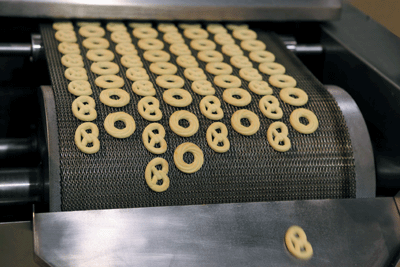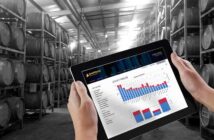Editors note: While the article is directly applicable to the US and slanted towards enhancing the value of purchasing SG Systems equipment, the analysis of the issues is valid and valuable information for New Zealand producers. NZ FOODtechnology makes no endorsements to purchase this or any other similar data collection systems.
In modern times, it’s difficult to find a bakery or food production facility which hasn’t already invested financially in some kind of traceability process to enable the tracking and tracing of ingredients used within their processes.
It’s a given that in most cases, once ingredients are received into a food manufacturing facility, ingredient traceability takes four routes through a manufacturing process.
Bulk ingredients delivered to a mixer directly through bulk delivery systems, minor ingredients manually added to the mixer in the form of whole or part bags, micro ingredients hand scaled and added to the mixer manually plus topping ingredients which are added post mixing to the divided and portioned batch.
How easy is it to track a finished product back through to a manufactured batch, through the bulk, minor and micro ingredient control systems and then back to the supplier?
Lots of systems offer part control of these processes and then still rely on a manual transfer of data through hand written records to form a paper trail.
Given that the US Food and Drug Administration and some major retailers provide timeframes for ingredient recall of anything from two days to four hours and downward, is it really possible to track and trace ingredients through these stages of delivery when a single micro ingredient such as an enzyme could be weighed into literally hundreds of formulations and batches across many weeks of production and be present in possibly millions of finished products?
Definitely a food recall nightmare for the unprepared.
So, where’s the opportunity?
SG Systems explores three common options in the US and the pros and cons of each.
Option one – Do the minimum
Doing the minimum in the US requires compliance with the Bioterrorism Preparedness Act 2002 and involves simple record keeping of goods received and shipped finished goods. A manual process of paper records can achieve this, but you need to keep records from anything from six months through to two years, depending on the category of your goods sold.
However, in the event of a recall of a raw ingredient such as salt, if you don’t keep track of ‘when and where used’ then you have virtually no way of knowing to whom it was shipped. The only way to cope with this situation is to recall entire days, weeks or possibly months of production costing thousands of dollars and huge brand damage.
In some US meat processing plants, it’s not unheard of for companies to be recalling millions of kgs of beef in a desperate attempt to keep their business reputation, but it’s often too late. Having no idea about where you used your ingredients is now a very high risk strategy and the return on investment from setting up a paper system and administration is definitely non-existing.
Verdict – Non-existent return on investment, high risk to brand and shareholder value
Option two – invest heavily in manual record keeping
Taking the Bioterrorism Preparedness Act one stage further and investing in more paper trails to keep track of ‘where used’ in the production facility is the common approach to satisfying retailers looking for damage limitation during the ingredient or finished product recall process. Manually recording ‘where used’ is often done by making operators complete paperwork to record which lot numbers have been used in each batch.
This administration allows a recall to be batch specific, limiting the recall times and providing the manufacturer with an opportunity to trace back where an ingredient has been used and more importantly, where and who it was distributed to.
However, the cost of implementing this administration is fixed and reoccurring.
Having teams of administrators filling in data is expensive, complicated, time consuming and problematic and makes powerful retailers and auditors squirm due to the opportunity for human error during the manual data recording process.
On top of this, being able to track the usage of an ingredient which has been used within hundreds of batches can involve many administrators and QA staff searching through hundreds or even thousands of batches to see if the ingredient had been used at all.
To counter this searching process, many companies are making their administrators and quality assurance (QA) employees manually enter data into an enterprise resource planning (ERP) or manufacturing resource planning (MRP) system.
This vastly reduces the recall times and makes retailers feel more comfortable.
So, after the cost of ERP/MRP purchase and implementation and the QA staff required to manage the process and manually record the data, organisations can be running into hundreds of thousands of annually reoccurring costs, having a direct impact on profitability and absolutely no return on investment, presenting a competitive risk.
Verdict – Non-existent return on investment, low risk to brand, high risk to shareholder value through increased permanent costs
Option three – Invest moderately in data collection automation
Taking the needs of the Bioterrorism Preparedness Act into account, the demands on the retailers to reduce recall times and also the desire to keep administration costs low requires some ‘out of the box’ thinking. It also requires management teams who have the strength and willingness to lead change and embrace technology.
These leaders are often found in senior technical or QA functions of the world’s most successful food producing companies.
But they haven’t got there through investing in technology unwisely – more by investing in the right technology which produces fast returns on investment to make their companies appealing to retailers and shareholders.
Paper trails do the job, but are costly and deliver no return on investment.
SG Systems have developed a system called ‘Vantage’ Traceability which is available in most countries. It’s a system which places the necessary controls on the production floor to capture and control inventory lot numbers and ingredient usage from actual production floor events.
Vantage ensures lot numbers are captured at the receiving, weighing, mixing, portioning-and shipping stages eliminating all paperwork and administration.
Usages at the bulk, minor and micro ingredient levels are recorded automatically as lot numbers are added into the mix – even controlling the weights added through the hand scaling processes to reduce waste.
The system forces correct weights to be added and the inventory to be used in correct rotation.
The return on investment comes in five key areas.
1. Controlling the micro ingredient scaling process enables exact weight to be hit and their lot numbers automatically recorded. Integration with ERP/MRP means no manual data recording and usages can automatically drive down inventory (perpetual inventory system) to provide real visibility and enable accurate, prudent ingredient purchasing.
2. Interfacing with bulk delivery systems enables lot number usages to be accurately tied to micro and minor ingredients added at the mixing process. This control allows for complete batch traceability without costly administration and manual ERP/MRP updates.
3. Electronically interfacing with sales order processing allows manufactured batches to be linked to a finished product count on the production floor
and the batch numbers allocated during the shipping process. This allows shipped products to have a direct relationship with the manufactured batch and ingredient used.
4. No recall administration. Vantage eliminates manual handling of ingredient data to have a direct financial impact on your bottom line profitability by significantly reducing the hours spent on ingredient traceability administration.
5. Brand protection. Having the tightest possible traceability means you can respond to recalls and pull your products in literally minutes. Over and above the retailers traceability requirements.
Verdict – six month return on investment, low risk to brand, low risk to shareholder value
For more information:
Visit: www.sgsystemsusa.com





























































































